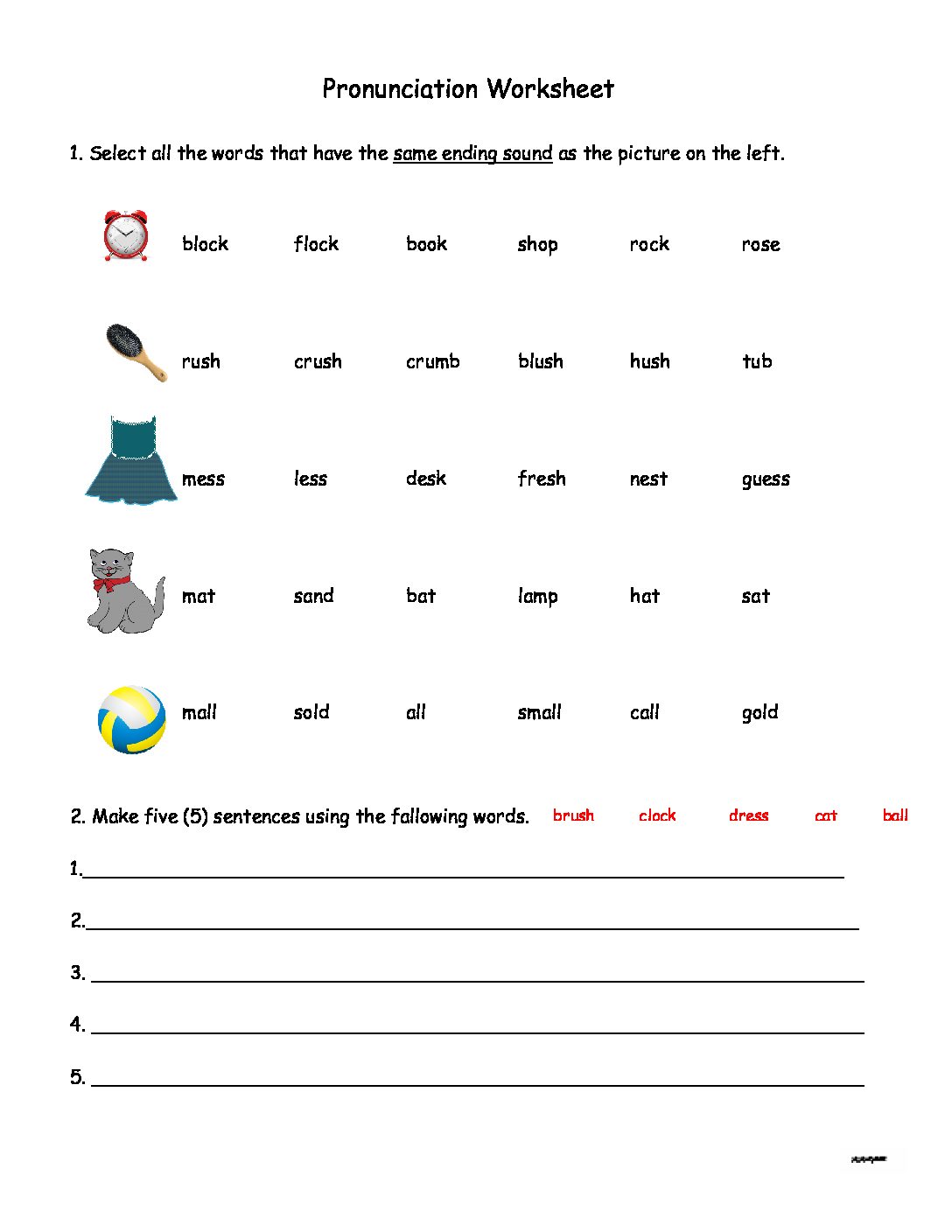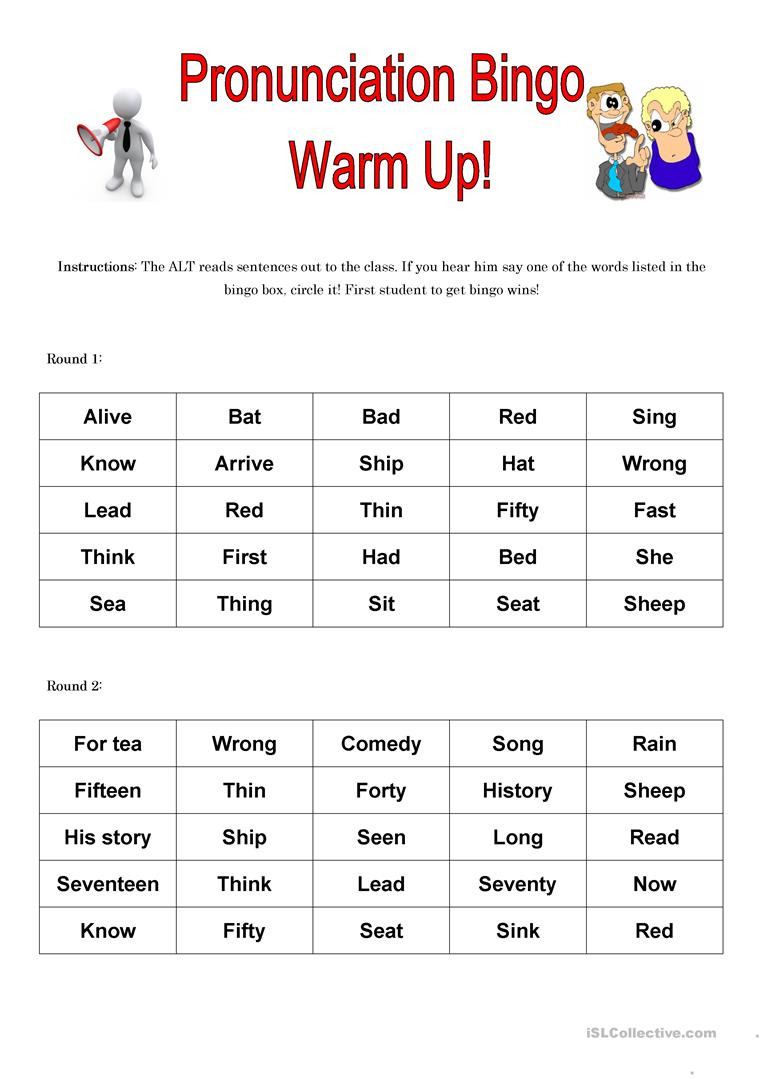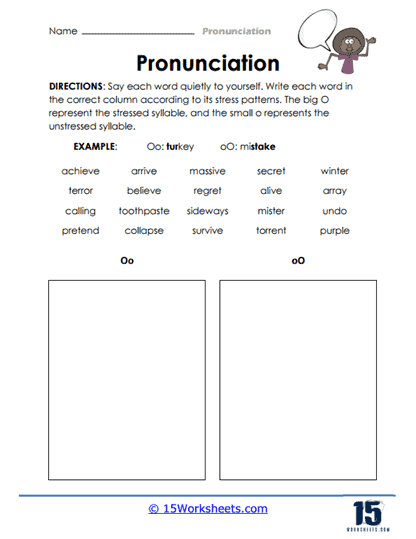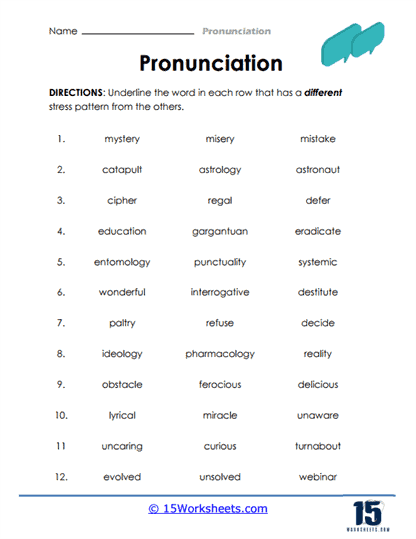
Mastering the Spoken Word: The Indispensable Role of Pronunciation Worksheets
In the vast landscape of language acquisition, mastering grammar, expanding vocabulary, and understanding syntax are undeniably crucial. However, one element often overlooked, yet profoundly impactful, is pronunciation. The ability to articulate sounds, words, and sentences clearly and intelligibly is the cornerstone of effective communication. Without it, even the most grammatically perfect sentences can lead to misunderstandings or, at worst, communication breakdown. This is where pronunciation worksheets emerge as an invaluable resource, providing structured, targeted practice that bridges the gap between theoretical knowledge and practical application.
This comprehensive article will delve into the profound importance of pronunciation, explore the diverse types of pronunciation worksheets, outline their significant benefits for both learners and educators, provide guidance on creating and effectively utilizing them, and finally, consider the nuances that maximize their impact.
Why Pronunciation Matters: Beyond Just Being Understood

Pronunciation is more than just making the right sounds; it’s about conveying meaning, expressing emotion, and building confidence. Poor pronunciation can lead to:

- Misunderstandings: A slight difference in vowel sound can change "sheet" to "shit," leading to awkward or offensive misinterpretations.
- Lack of Confidence: Learners who are constantly misunderstood or self-conscious about their accent may become hesitant to speak, hindering their overall language development.
- Communication Breakdown: If a speaker’s accent is too strong or their articulation unclear, listeners may struggle to process their message, leading to frustration for both parties.
- Perception and Credibility: While accents are a natural part of identity, unintelligible pronunciation can sometimes unconsciously affect how a speaker’s message is received or how credible they are perceived to be.



Given these challenges, dedicated practice is essential, and this is precisely where pronunciation worksheets play a pivotal role. They offer a systematic way to isolate, practice, and master the intricate sounds, stresses, and rhythms of a new language.
Deconstructing Pronunciation Worksheets: Types and Their Targets

Pronunciation worksheets are not a monolithic entity; they come in various forms, each designed to target specific aspects of spoken language. Understanding these types allows educators to select or create materials that precisely meet their learners’ needs.
-
Minimal Pair Worksheets: These are perhaps the most fundamental. Minimal pairs are words that differ by only one sound (e.g., "ship/sheep," "lice/rice," "think/sink"). Worksheets for minimal pairs typically involve:

- Listening Discrimination: Students listen to pairs of words and identify whether they are the same or different.
- Production Practice: Students read aloud the pairs, focusing on distinguishing the target sounds.
- Sentence Context: Students use the words in sentences to practice the sounds in a more natural flow.
These worksheets are crucial for learners struggling with specific phonemic distinctions that don’t exist in their native language.

-
Tongue Twister Worksheets: Designed for fun and fluency, tongue twisters (e.g., "She sells seashells by the seashore," "Peter Piper picked a peck of pickled peppers") target:
- Articulation Practice: Repeatedly producing tricky sound sequences.
- Fluency and Rhythm: Building speed and smoothness in speech.
- Muscle Memory: Training the mouth and tongue for rapid, accurate movements.
Worksheets might ask students to practice the twister, identify the repeating sounds, or even create their own.
-
Word Stress and Sentence Stress Worksheets: English is a stress-timed language, meaning certain syllables and words are emphasized more than others.
- Word Stress: Worksheets might present multi-syllabic words and ask students to mark the stressed syllable (e.g., "pho-TOG-ra-phy," "IN-for-ma-tion").
- Sentence Stress: Worksheets might provide sentences and ask students to identify which words carry the most emphasis to convey specific meaning (e.g., "I didn’t say he stole the money" vs. "I didn’t say he stole the money").
These are vital for improving intelligibility and natural rhythm.
-
Intonation Worksheets: Intonation refers to the rise and fall of the voice, which conveys meaning, emotion, and grammatical structure (e.g., questions often have rising intonation, statements falling).
- Worksheets might present dialogues or sentences and ask students to draw arrows indicating the intonation pattern.
- They could also involve listening tasks where students identify the emotion or intent conveyed by different intonation patterns.
-
Rhyme and Rhythm Worksheets: These often incorporate poetry, songs, or simple chants to help learners grasp the rhythmic patterns of English.
- Students might identify rhyming words, clap out syllables, or mark the beats in a sentence.
- This type of worksheet can be particularly engaging and helps connect pronunciation to more enjoyable aspects of language.
-
Connected Speech Worksheets: In natural speech, words often link together, sounds change, or disappear (e.g., "going to" becomes "gonna," "would you" becomes "wouldja").
- Worksheets present common phrases or sentences and highlight instances of linking, elision, or assimilation, guiding students to practice these natural phenomena.
- This is crucial for understanding native speakers and sounding more natural themselves.
-
Listening Discrimination Worksheets: Before students can produce sounds accurately, they often need to be able to hear the differences.
- These worksheets involve audio clips where students identify specific sounds, distinguish between similar-sounding words, or recognize intonation patterns.
- They often serve as a pre-cursor to production practice.

The Manifold Benefits of Incorporating Pronunciation Worksheets
The systematic use of pronunciation worksheets offers a wealth of advantages for both language learners and educators:
- Targeted Practice: Unlike general speaking activities, worksheets allow learners to focus intensely on specific sounds, stress patterns, or intonation contours that are challenging for them. This precision accelerates improvement.
- Independent Learning and Self-Correction: Many worksheets are designed for self-study, empowering learners to practice at their own pace, revisit difficult areas, and develop self-correction strategies. Answer keys or audio components facilitate this independence.
- Reinforcement and Repetition: Mastering pronunciation requires consistent repetition. Worksheets provide a structured framework for this necessary practice, embedding sounds and patterns into muscle memory.
- Variety and Engagement: While practice can be repetitive, well-designed worksheets can introduce variety through different exercise types, visuals, and engaging content, preventing boredom.
- Assessment Tool: Worksheets can serve as informal assessment tools for teachers, quickly identifying common pronunciation errors across a class or pinpointing individual weaknesses. They also allow learners to track their own progress.
- Reduced Speaking Anxiety: By practicing challenging sounds in a low-stakes, written format before producing them orally, learners can build confidence and reduce anxiety associated with speaking.
- Bridging the Gap: They provide a tangible link between abstract phonetic rules and the concrete act of speaking, helping learners internalize concepts like IPA symbols or stress rules.
- Flexibility: Pronunciation worksheets can be used in various settings: in-class, for homework, in language labs, or as supplementary material for online learning.
Crafting Effective Pronunciation Worksheets: A Guide for Educators
Creating impactful pronunciation worksheets requires careful consideration of design, content, and integration of technology.
- Clear, Concise Instructions: Learners, especially those working independently, need to understand exactly what is expected of them. Use simple language and provide examples.
- Authentic Language and Context: Avoid isolated words. Present sounds and patterns within meaningful words, phrases, and sentences that learners are likely to encounter in real communication.
- Scaffolding: Start with easier exercises and gradually increase the difficulty. For instance, begin with listening discrimination, move to controlled production, and then to freer practice.
- Visual Aids: Incorporate elements like:
- IPA (International Phonetic Alphabet) symbols: Essential for precise sound representation.
- Mouth diagrams: Show tongue and lip positions for specific sounds.
- Stress marks: Clearly indicate stressed syllables or words.
- Intonation arrows: Illustrate rising and falling pitch.
- Crucial Audio Integration: This is perhaps the most critical element. Text alone cannot convey sound. Every pronunciation worksheet should ideally be accompanied by high-quality audio recordings by native speakers. This allows learners to:
- Hear the target sounds accurately.
- Model their pronunciation after correct examples.
- Check their own production against the audio.
- Provide Answer Keys/Self-Correction Mechanisms: For independent learning, clear answer keys or prompts for self-correction are vital. This could include transcriptions, stress markings, or explanations.
- Variety of Exercise Types: Mix and match different exercise formats (fill-in-the-blanks, matching, circling, dictation, role-playing prompts) to keep learners engaged.
- Focus on Common Errors: Design worksheets that specifically target the pronunciation difficulties common among your learners (e.g., L/R distinction for East Asian speakers, ‘th’ sound for many European speakers).
Maximizing Impact: Effectively Using Pronunciation Worksheets in Practice
Having well-designed worksheets is only half the battle; their effective implementation is key to success.
- Pre-Teaching and Modeling: Before students dive into a worksheet, the teacher should clearly model the target sounds, stress patterns, or intonation contours. Explain the mechanics (e.g., how the tongue moves for a particular sound).
- Guided Practice: Begin by working through a few examples together as a class. This ensures understanding and allows for immediate correction.
- Independent Work: Assign sections of the worksheet for individual completion, allowing students to practice at their own pace.
- Pair and Group Work: Encourage students to practice aloud with a partner, providing peer feedback. This also makes the activity more interactive and less intimidating.
- Feedback and Correction: Provide constructive feedback. Focus on intelligibility rather than aiming for a "perfect" native accent. Highlight patterns of error rather than correcting every single mistake. Encourage self-correction by having students listen to their own recordings and compare them to the model.
- Integrate with Communicative Activities: Worksheets are a tool, not the end goal. After practicing sounds or patterns, integrate them into freer communicative activities. For example, after practicing minimal pairs, have students use those words in a debate or a role-play.
- Review and Recycle: Periodically revisit previously covered pronunciation points to ensure retention.
Challenges and Considerations
While pronunciation worksheets are immensely beneficial, it’s important to acknowledge their limitations and integrate them thoughtfully into a broader curriculum:
- Not a Standalone Solution: Worksheets are excellent for targeted practice, but they cannot replace authentic, spontaneous speaking opportunities. They are best used as a foundation for, and complement to, communicative activities.
- Reliance on Audio: Without quality audio, the effectiveness of pronunciation worksheets is severely diminished. Teachers must ensure access to clear recordings.
- Teacher Expertise: Educators need a foundational understanding of phonetics and phonology to effectively teach and correct pronunciation, even with the aid of worksheets.
- Motivation: Some learners may find repetitive pronunciation drills tedious. Varying worksheet types, incorporating games, and connecting pronunciation to real-world communication can boost motivation.
Conclusion
In the pursuit of linguistic fluency, pronunciation often remains the elusive final frontier for many language learners. While grammar and vocabulary lay the groundwork, it is clear and intelligible pronunciation that truly unlocks effective communication and fosters confidence. Pronunciation worksheets, in their diverse forms, stand as an indispensable tool in this journey. They offer structured, targeted, and repeatable practice, allowing learners to dissect, analyze, and master the intricate sounds, rhythms, and stresses of a new language.
From the precise distinctions of minimal pairs to the fluid melodies of intonation, these worksheets provide the essential scaffolding for building strong phonetic foundations. By empowering learners with independent practice, offering educators a versatile teaching resource, and bridging the gap between theory and application, well-designed pronunciation worksheets are not just supplementary materials; they are fundamental components of a comprehensive and effective language learning curriculum. Embracing and integrating them thoughtfully will undoubtedly lead to more confident, clearer, and ultimately, more successful communicators.
